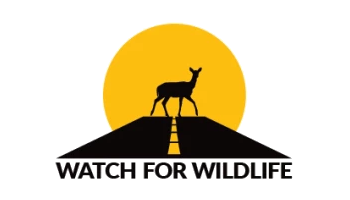Saturday, October 7, 2017
About 200 animals a year are brought to the Cobequid Wildlife Rehabilitation Centre for treatment after being struck by vehicles. One was this red fox, which survived. (Murdo Messer/Cobequid Wildlife Rehabilitation Centre)
There are few species in Nova Scotia that drivers haven't crushed with their tires, bludgeoned with their bumpers or walloped with their windshields.
Snapping turtles, bald eagles and even bobcats and bears have all been felled by the automobile — and some species are feeling the strain on their population.

It can take some animals a while to recover after they've been struck by a vehicle. (Murdo Messer/Cobequid Wildlife Rehabilitation Centre)
Source:
Friday, May 19, 2017
Ian Murray is kindly letting us use his award winning image of 'Mom' and kit for Watch for Widlife collision prevention awareness. Ian is a photographer from Wallace, NS. Mom (who was actually a dad) was killed by a car (story below, by CBC). Mom is the new face of wildlife vehicle collsion prevention in Nova Scotia. In memory of 'Mom', we will try harder to reduce their injury and deaths on our roads.
Source:
http://www.watchforwildlife.ca/blog/a-famous-fox-is-remembered-and-honoured-by-w…
Wednesday, September 28, 2016
Watch for Wildlife Nova Scotia has joined a large and growing family of programs around the world working to reduce wildlife vehicle collisions on our roads. In California, we have the California Roadkill Observation System (http://wildlifecrossing.net/california), which we started in 2009 to give us a way to record wildlife carcasses on roads and highways. We collect the wildlife data to improve the way we manage human activities, like traffic and roads. We followed this with a system for Maine (http://wildlifecrossing.net/maine) which has similar approaches, with more widgets and buttons like transect monitoring and the ability to record “no wildlife” observations.
Source:
http://www.watchforwildlife.ca/blog/watch-for-wildlife-joins-an-international-mo…
Sunday, August 14, 2016
In the early fall of last year, while driving home down the Bedford Highway, I saw something which I never quite forgot. The vehicles on the road ahead of me were merging into the opposite lane to avoid some obstacle ahead and I followed suit, not laying eyes on the tragic scene until I was nearly alongside. It was a cat, the lower half of its body crushed by the unforgiving treads of a fellow motorist, and it was alive, flailing and writhing with agony beyond my comprehension.
The sight of such useless and unnecessary suffering bothered me a long time and the part which bothers me still is that I kept driving. I and everyone else gave this poor creature space when it needed it least, instead of pulling over and doing something. I think most of us felt helpless in the face of such pain, unsure of what to do and thus embracing inaction.
Source:
http://thechronicleherald.ca/thenovascotian/1388407-the-perils-of-sharing-our-ro…
Sunday, June 19, 2016
My wish for Father’s Day is that more people start thinking about and acting like my dad does when it comes to wild animals hit by vehicles. Wildlife deserves our attentiveness while driving and our respect and decency when they are the casualties of collisions.
Read Wanda's full Commentary article here.
Photo credit: Therese Bombardier
Source:
https://www.localxpress.ca/opinions/commentary-my-father-taught-me-to-love-mothe…


